It was raining when we landed in Bandung, Indonesia. It was one of those flights where you deplane outside on the tarmac and walk into the airport terminal on a path lined with orange cones to keep passengers from wandering onto an active runway.
“Great, we’re definitely going to get wet.” I thought.
But I was wrong. Two airport employees stood in the rain at the bottom of the airplane stairs, smiling and handing out umbrellas to every single passenger.
Tim and I have never seen anything like it before. You just don’t find that level of customer care. The small gesture was thoughtful and kind, and immediately I was so happy to be in Indonesia.
Over the course of the following three weeks, we learned this experience wasn’t a fluke. People in Indonesia are just nice like that. The warmth of the people we met and the beauty of everything we saw put Indonesia solidly on our list of favorite countries.

So happy to have an umbrella!
Itinerary:
- Days 1-2: Bandung and Kawah Putih (White Lake)
- Days 3-5: Batukaras and Green Canyon
- Days 6-9: Yogyakarta
- Day 10: Surabaya
- Days 11-13: Surabaya to Bali tour via Madakaripura Waterfall, Mount Bromo and Mount Ijen
- Days 14-16: Bali (Nusa Dua)
- Day 17: Labuan Bajo
- Days 18-20: Komodo National Park
- Day 21: Depart
Dates: May 19-June 7, 2018
Our Odyssey:
Java
We arrived in Bandung, on the island of Java, in the early afternoon that Saturday. Java is one of the largest of Indonesia’s countless islands (literally, they don’t know exactly how many there are), and is the most densely populated island in the world.
We used SPG Points to stay at the Four Points by Sheraton Bandung. The staff at reception greeted us with delicious ginger tea and warm smiles. Our room was lovely and comfortable with a large, beautiful bathroom.
Settled into our room, we did a little research on what we’d like to do the next day (our only full day in Bandung). We weren’t particularly interested in exploring the city, having just spent a lot of time in big cities in Malaysia and Singapore. Instead, we decided to book a tour to the countryside about an hour south of the city.
The next morning our guide picked us up from the hotel. We headed straight for Kawah Putih for our first stop. The road winded from the city congestion to the village congestion. The small towns sit right on the main road, so it was slow going. Eventually we arrived to a parking area. Our guide explained he would wait there for us while we road on a trolley-like vehicle to the crater lake itself.
We could tell we were getting close before we even saw the lake. The strong sulfuric odor is unmistakable.
We disembarked our shuttle and walked the short path to the lake. An ethereal and almost mystical view awaited us.
Steam rose from the milky turquoise lake, circling the bare branches of scattered trees growing out of the yellow mud. Behind the lake sits a comparatively lush and green hill, contrasting starkly with the barren crater lake.

With masks over our mouths and noses to block the potentially harmful fumes, we walked around, taking in the unique views for about 45 minutes before getting on the shuttle to meet back up with our guide.

From there we continued traveling through the countryside, stopping at tea fields and a deer sanctuary.
The next day, Monday, was one of the most miserable of our trip so far. Here’s why.
We had booked what we thought was a bus online to go from Bandung to our next destination – the small surfing and fishing town Batukaras. We knew it was a long 6 hours on Google Maps, but we didn’t realize we were traveling in a basic SUV with 5 other passengers, plus their luggage. We ended up crammed in the backseat with our bags more or less in our maps for the duration of the ride. Eight hours, two bathroom stops and no food later, we finally arrived at the guesthouse we’d booked in Batukaras.
Thankfully, the place itself was very nice. Situated right on the Green River and a 10 minute walk to the beach, the Dahon Bungalow guesthouses (which we booked on Airbnb) were quaint, comfortable and scenic.

The next day we relaxed, caught up on some writing, and read. We walked into the beach town for food, watched the surfers and generally just recharged from the long travel day we’d had.
On our last full day there, we tried something new – body rafting. A mix between canyoning, white water rafting, hiking and swimming, body rafting really just means wearing a life jacket and a helmet and floating down the river.
During the dry season, visitors and locals alike will body raft through the Green Canyon. The trip starts with a bumpy ride in the back of a pick up truck to a high point on the river. After a short hike, you get in the water and off you go! Far from relaxing, the activity requires a lot of climbing, jumping and swimming. Along the way we saw a huge monitor lizard who slithered into the water at lightening speed, a million crabs smaller than my thumb nail, and plenty of bat guano. This is not for the squeamish.
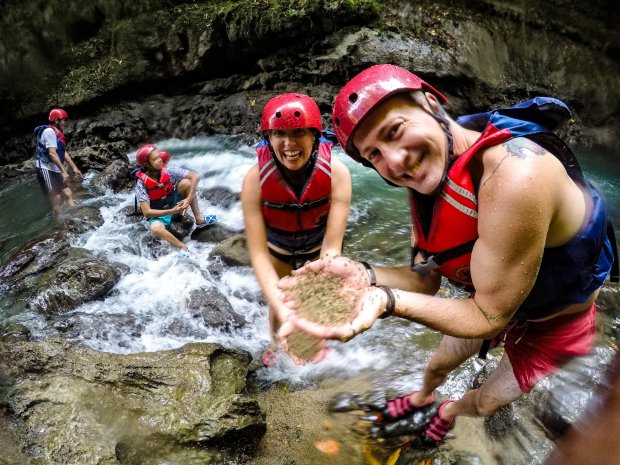
One moment in particular really challenged my mental strength. We were entering into a cave and were up on the rocky shelves above the river. The terrain was increasingly challenging, especially for me and my fear of falling. I came to a decision point. To my left, I would have to scale a jagged and steep rock with nothing to protect me from falling into the shallow and rocky water below. To my right, the trail was flat, but covered in a literal blanket of small, crawling maggots.
I was completely stuck. It wasn’t until Tim breezed right past me and chose the maggot path that I made my move.
As I stepped into the pit of maggots, my feet sank. They weren’t just covering a rock surface. They were layered, one atop the other, several inches deep. I made it over and got back in the water as soon as I could to wash off any clingers.


The stunning scenery and moments of peaceful drifting on my back more than made up for the challenges. Even better, this canyon is way off the international tourist trail – I can’t even find a website describing the tour in English, and everyone else in our group was local to Indonesia.
It was one of the most exciting days on our trip so far, and we felt that unique satisfaction that only comes when you’ve challenged yourself and stepped outside your comfort zone.


My smile is proof that it was fun
Leaving Batukaras, our next destination was Yogyakarta. This is one of Indonesia’s most touristy areas because of the ancient historical Buddhist and Hindu temples that dot the area.
We redeemed SPG points to stay at the Sheraton Mustika for free, and it was amazing. The hotel has an old-money vibe that is borderline dated. To me, though, this was part of its appeal. The decor and furniture felt like we were staying in some rich family’s mansion. Free breakfast and evening hors d’oeuvres meant we barely spent any money on food in Yogyakarta.
We also had a plate of fruit in our room waiting for us when we arrived. We were familiar with most of the fruit (grapes, apples) but there was one we didn’t recognize. It was spiky and brown, so naturally we Googled “spiky brown Indonesia fruit”. The result – snake fruit. The name totally made sense, as the rind of the fruit resembled the snake scales.
We were not sure how to eat it, so we had to look that up too. It turns out you just peel off the skin and inside is a soft fruit with an earthy sweetness and a texture similar to a pear. We both liked it and enjoyed trying a fruit we didn’t even know existed previously.
With a few days in Yogyakarta, we were able to spend time relaxing at the hotel for an entire day. For our day out exploring, we booked this tour using our Chase Ultimate Rewards points. This is another way we ended up spending hardly anything in Yogyakarta.
Borobudur, an ancient Buddhist temple complex, is Indonesia’s biggest tourist attraction. Construction started in 825 AD, but it wasn’t until the 1800s that the complex drew international attention, or even domestic attention for that matter. For the better part of a millennium, the complex was more or less abandoned. A $25 million USD restoration project later, 2.5 million tourists now visit annually.

To enjoy the visit, most people recommend coming as part of a sunrise tour. This gives visitors access to the complex before it officially opens. In particular, we found that lingering around after the sunrise crowds leave but before the day time groups arrive is well worth it to have a bit of solitude.
While 3 am is not my favorite time to wake up, I’ve slept less for worse.
Our morning started with our guide telling us there’s a slim chance we wouldn’t be able to go to Borobudur because of volcanic activity nearby. Apparently this is totally normal.
The volcano didn’t erupt, thankfully, and we got to explore the world’s largest Buddhist monument among a relatively small number of other tourists.
Borobudur sits wrapped around a hill, with many layers and hundreds of stupas. The intricate relief carvings in stone across the massive structure make the monument impressive to look at both close up and from afar.

Pro tip- wait until a little bit after sunrise to take photos at the temple. Most of the sunrise crowd will have dispersed and you’ll have the place to yourself!

Stupas at Borobudur
After the Borobudur temple, our guide took us to the very tiny Mendut Temple. While quite small, this temple was one of our favorite parts of the day, and not just because its home to one of the only large Buddha statues still in its original location.
What made Mendut so memorable was our guide’s seemingly impromptu decision to introduce us to a local family. They invited us into their home, showed us how the make caramel (yum!), offered us tea and fed us Indonesian snacks (more yum!). Tim and I both felt grateful for the whole experience.
Afterwards, we hopped on bikes to continue our exploration with our guide. I enjoy bike riding, and knew we’d be doing some on this tour. What I didn’t realize, however, is that we’d be riding on the road with plenty of car and motorbike traffic.
When we turned onto the main road and I saw all the cars coming towards us, I became paralyzed. I flashed back to 2014, when I had a bike accident in Argentina due to a semi truck clipping my handlebars. I wasn’t injured or worse, but only because I happened to fall away from the truck instead of under it. I’ve been skittish about riding among motorized vehicles ever since.
“Nope nope nope.” I said as I hopped off the bike. “I can’t do it.”
Tim understood immediately why I stopped. Tim asked our guide if we’d be on main roads like this the whole ride (which would be over the next 2 hours) or if we’d be getting out to more rural paths.
He assured us that once we turned left onto a small road that cut through fields just ahead of us that there wouldn’t be any car traffic. I walked my bike to that point and decided to try again.
Thankfully, once we were away from the cars I felt much better and more confident on the bike. We stopped at rice terraces, peanut fields and another small temple (Candi Pawon), before arriving at Prambanan Temple. I was admittedly glad to be off the bikes for good, but proud that my closest thing to a collision with a car was me getting scared and veering into a lamp pole back on the main road at the end of the ride.
Prambanan is the largest Hindu temple compound in Southeast Asia. Built around 900 AD, it has some strong Angkor Wat vibes thanks to its similar shape and Buddhist-Hindu mixed architecture. Our guide led us around and explained the motifs and stories behind the carved images and statues.


View of all of the temples at Prambanan
It was hot outside and there was quite a bit of climbing, but I always love exploring ancient ruins! We were also really lucky that there weren’t a ton of other visitors there that day.
Our tour also included a multi-course lunch of rice, tempeh (a fried soybean patty), fish and veggies. We had many delicious meals in Indonesia and this was no different.
From Yogya, we made our way to Surabaya, where we only stayed for one night because the next morning we began a three-day tour over eastern Java to Bali. Three American guys we met on our Tao sailing trip in the Philippines had recommended this route and the company they used (Discover Your Indonesia).
Our driver picked us up from our hotel that morning. He didn’t speak much English, but it was enough to get the essentials covered.
Our first stop was Madakaripura Waterfall, which is the tallest waterfall in Java. Cars cannot access the trailhead, so our driver dropped us off at the car waiting area. From there Tim and I hopped on the back of mopeds and rode the rest of the way to the start of the trail. At that point we were handed off one last time to a local guide who led us down the trail. Since everything was included in the tour, we didn’t have to sort out any of the logistics. We were just sort of passed on to the next person at each step.
The walk to the waterfall was short but exciting. Our driver had told us to bring our rain jackets, because you actually have to hike through a few waterfalls to get to the tallest one. We definitely were soaked but it was a fun time. The falls themselves are very tall and thin, and the smaller surrounding falls along the rock walls make it feel prehistoric in a way.

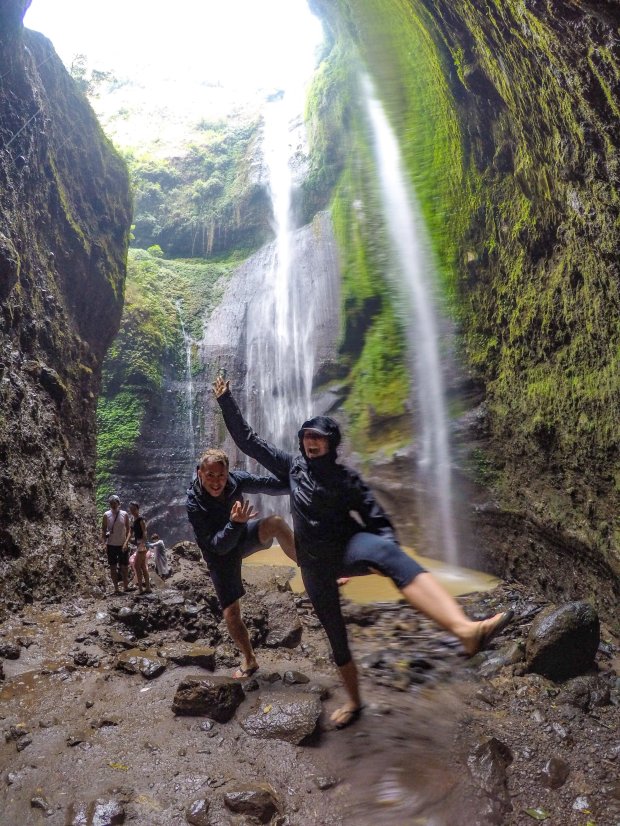
Trying to do yoga at Madakaripura Waterfall

Hiking through Madakaripura Waterfall
In the afternoon we reached our hotel near Mount Bromo. The air was noticeably cooler and rolling hills surrounded the area. We’d be getting up really early the next morning for another sunrise tour the next day, so we just relaxed for the evening.
At 3am our driver arrived in a 4×4 to take us to the sunrise view point over Mount Bromo. To be honest, I’m not a “sunrise person”. I haven’t been particularly impressed by many (though the one at Angkor Wat was worthwhile) and I’m definitely not a morning person. But, it seems like sunrise is the best time to see anything on Java so I kept an open mind.
It took about an hour to get to the drop off point on Mount Penanjakan overlooking Mount Bromo. From there, Tim and I walked about 15 minutes to the view point. It was dark and we weren’t really sure where to go, so we just followed everyone else.
When we arrived we scoped out the best viewing spots by scanning the area to see where and how people had set up their cameras. We grabbed an open space near the front railing next to a woman who had a bendy tripod set up on the middle rung. She looked like she knew what she was doing so we followed suit and set up our bendy tripod with the GoPro on the top rung.
It was still completely black and we had little idea of what kind of scene to expect. After some trial and error, however, I discovered how to take extended exposure shots with my GoPro. What we saw as a result of the extra light coming in wowed us. We were standing in front of not just one volcano, but several, all of different heights and layered against each other.
As the sun rose, the light revealed three volcanic cones, all sitting within what appeared to be a crater. Plumes of smoke and ash puffed from the top of the furthermost volcano. The rays of light coming from the left of us illuminated the parallel ridges on Mount Bromo, the front-most cone. Meanwhile, the sky danced from purple to pink to blue as the day awakened before our eyes. I felt like we were flipping through images in a National Geographic magazine, except that it was real life.

This was worth losing sleep over.
After sunrise Tim and I walked back down the hill to meet our driver. The road was packed with hundreds of other old Toyota Land Cruisers all carrying tourists off the mountain. We’d arrived before most of the others so we didn’t realize just how many vehicles were there until that moment. Tim and I have gotten so used to seeing crowds that we’re sometimes blind to the insanity of it. We’re just as guilty as anyone else there, but it’s clear Mount Penanjakan doesn’t have space to hold many more vehicles each morning. Like other heavily touristed sites around the world, it seems like at some point soon authorities will need to implement a daily limit on the number of sunrise visitors, as much for safety as for the health of the mountain.
Once our driver was able to weave the vehicle back down the mountain, he drove us into the seemingly endless sandy basin (Laotian Pasir or Sea of Sand) in which the three volcanos sit. From here, we had the option of ascending Mount Bromo.

In addition to all of the Land Cruisers, hundreds of horses tethered to their owners kick up dust around the crater. For a fee, tourists can “rent” the horses for a partial ride up the mountain. Tim and I prefer to avoid animal riding of any kind (though we are guilty of having ridden elephants, horses and camels in the past), and Tim is allergic to horses anyway. Our obvious choice was to walk up the mountain.

Over the next hour, we inhaled clouds of sand, horse dander and volcanic fumes. With itchy eyes and sore throats we made our way up to the crater rim where we were able to peer directly into Bromo’s steamy caldera.
Admittedly the view out over the expansive desert impressed us more than the one into Mount Bromo’s crater. From that vantage point it was easy to see why it was called a “Sea of Sand”. The scene looked simultaneously like something out of the Old Testament and like the setting for a post-apocalyptic YA novel. Despite my physical discomfort, the surreal landscape captivated me.
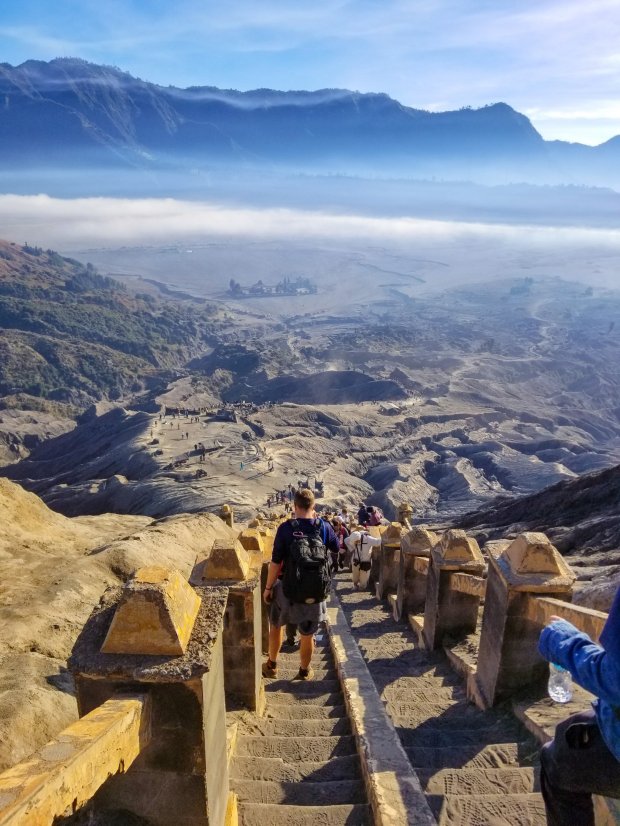

Looking out over the Sea of Sand

View over the Sea of Sand from the summit of Mount Bromo
From here it was back to our hotel for breakfast and a brief rest before our driver picked us up again to continue our journey. We were now heading to a small town near Mount Ijen.
It was another night of short sleep, as our guide for Mount Ijen volcano (2368m) picked us up around 1am to make the one hour drive to our destination.
This volcano is unique, but not just because its acidic crater lake is the largest on earth or that its more caustic than battery acid. It’s one of the last active sulfur mines on earth, and one of only two places in the world where you can see blue flames.
The mining work that happens here every day in the mine is not just physically difficult, it’s life-threatening due to the constant exposure to poisonous gasses.
The miners start their work in the middle of the night when the air is cool. They hike the approximate 3km steep climb to the rim of Kawah Ijen’s crater, and then descend another 600m into it. The sulfuric steam billows around the mine, revealing in its oscillations the vibrant blue flame that results from a chemical reaction between the sulfuric gasses below and oxygen above. This otherworldly scene is their office. For hours they chip away at the hardened sulfur. Once they have 150-200 lbs, they load up two wicker baskets held together with a bamboo rod, which is also used to carry the load on their shoulders. Then, it’s a steep climb back out of the crater to drop off the load before climbing back down to do it again. With two loads per day at about $5 each, miners are considered well-paid and well-respected in their communities.


Miners capture the liquid sulfur in an area and collect it once it has hardened
Up on the crater rim, tourists can buy knick knacks the miners carve from smaller chunks of sulfur crystal to make a little extra money. For a lot of extra money (one guide we met said 1 million rupiah, or about $70 USD), tourists can hire miners and local guides to rickshaw them up the steep mountain in the same carts used to bring the sulfur down.

The blue flames of Ijen, created by the mining activities, draw in hundreds of visitors each morning. With these numbers, the tourism industry is becoming more lucrative than the sulfur that started it all to begin with.
Our local guide, Eko, used to be a miner. “Mining is very difficult and very dangerous. This…” he said, referring to being a tourist guide, “This is much better.”
We managed the steep hike up to the rim, and from there we could see the hazy blue glow over the mine. Tim and I opted not to hike down into the crater to the mine, because it was still completely dark and the path was treacherous. Twisting an ankle would really change the course of our trip, and since we could see the blue flame from the rim, we were happy to stay put.

Our guide offered to hike down anyway to get pictures for us. We took him up on it, since he seemed to want to head down. Since he used to be a miner there himself, I figure maybe he wanted to say hi to friends or something.
Up on the rim, Tim and I got to watch the sunrise. As the sky brightened, the blue flame disappeared and a more beautiful site revealed itself. The volcano and its lake are some of the most breathtaking scenery I’ve ever seen. The sky was a perfect pinkish purple, complementing the gray of the rocks and the milky aqua of the acidic lake. The colors were so calming and peaceful – a dramatic contrast with how volatile and active this place actually is.

It’s hard to believe this moonlike landscape exists on earth

I’m still in awe of these colors
Once our guide was back, we started the hike downhill back to the car. We returned to the hotel for breakfast before starting the short drive to Banyuwangi. From there, we took a ferry to the island of Bali, and then still had 5 hours in a car to get to our hotel in Nusa Dua.
Bali
Nusa Dua is known for its beaches and resorts. It’s a relaxing and quiet area to stay. There are a handful of restaurants and shops, but mostly it’s the kind of place where you stay on the beach and relax. Since it’s very spread out, it’s not great for walking around, further encouraging you to just stay put at your resort.
And since Tim redeemed Hilton points for us to stay at the fancy Conrad Bali hotel, we definitely planned to just spend a few days relaxing. I had a bit of a head cold as well, so this was a nice place to convalesce. Our room was upgraded to a suite, we had several choices for pools, and the resort is right on the beach. But my favorite part was the sauna- perfect for draining out all my congestion. Sorry, travel isn’t always glamorous even when you’re at a fancy Bali resort.
We did venture out one day to explore Bali as much as we could. As it turns out, Bali is huge and now I understand why people spend weeks traveling around the island (and not just 3 days like we had).
We arranged for a driver to take us around to some of Bali’s most notable sights, starting with one of Bali’s several distinctive forms of dramatic dance, the Barong and Rangda. This particular one focuses on the battle between good and evil, as manifested via a lion and a witch.

I often wonder how authentic “cultural performances” are, but this one is legit! This style of dancing and musical story telling is so unique to Bali that UNESCO includes it on the Intangible Cultural Heritage list.
After the amusing hour-long performance, we then visited Batuan temple, a community Hindu temple. While Indonesia is a majority Muslim nation, most Balinese practice their own unique style of Hinduism mixed with some animism practices. There are temples all over the island, but this was the first one we actually visited.
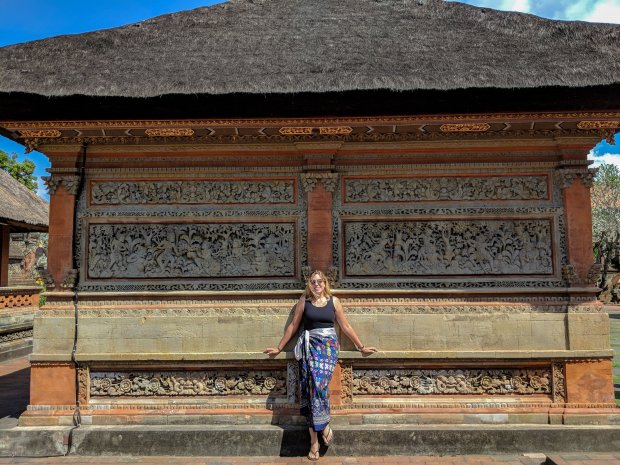

These symmetrical gates can be found all over Bali (and Instagram)
It was fun wandering among the buildings. I even got to wear a batik (woven) sarong, since the staff gave them to everyone to wear (a requirement out of respect at temples).
From there our driver took us to the Tegalalang Rice Terraces.
This is totally my fault for not doing thorough research, but the terraces at Tegalalang are not the idyllic, perfect, expansive ones you see pics of when you search “Bali rice terrace”. Turns out, there are several places to see rice terraces in Bali.
While UNESCO listed Jatiluwih terraces are considered the most scenic ones in Bali, the Tegalalang terraces are literally on the side of the highway surrounded by tourist souvenir shops.
They were also teeming with other visitors. To me, the vibe felt all wrong. Wasn’t this supposed to be serene countryside?
As I thought more about it while watching the locals working the fields, I realized my attitude was all wrong. This place has no responsibility to me to meet some idea of it I have in my head. It’s an active farm land and it’s supplying food for thousands of people. The fact that it’s in the middle of the village makes it even closer to the local and authentic way of life.
While I was definitely disappointed, I accepted it, but not before being a little grumpy for a few minutes.
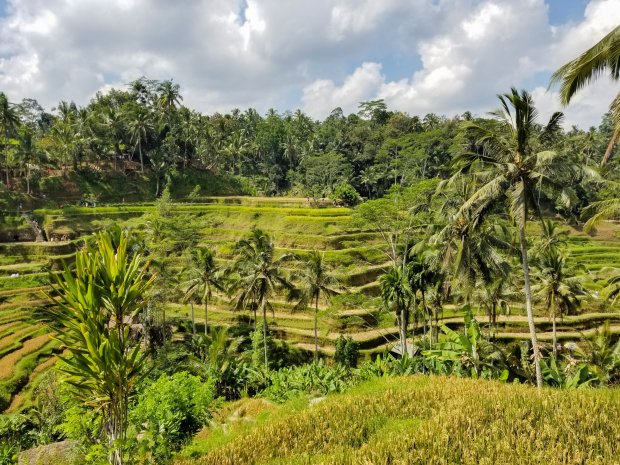

We stopped for a mediocre lunch overlooking a scenic extinct volcano. Between my cold and my disappointment at the rice terraces, my energy was waning.
The next stop definitely perked me up. We visited a coffee plantation where we were able to sample a dozen or so varieties of coffee and tea. Allegedly, this region is home to the best coffee in the world – luwak coffee.
A luwak is a wild cat-like animal who eats coffee beans. The luwak partially digests the beans and then, well, poops them out. People then clean the beans off thoroughly and roast them to make a naturally caffeine-free and less bitter coffee. We tasted it and really didn’t taste any different to us than regular coffee, but I’m not exactly an expert.
It’s worth noting that not coffee plantations treat the luwaks very well. Where we were, they were free to roam around and eat what they want (or so our guide said). In other places, they can be caged and force-fed to produce higher amounts of the lucrative beans.
Regardless, I had a lot of fun trying all the different kinds of tea especially, and we left with a potent ginger tea and a sweet, creamy tea made from the pandanus tree (which we’d never heard of before).
We ended the day at Uluwatu Temple, which is perched high on the cliffs overlooking the Indian Ocean on Bali’s southwest coast. We enjoyed sunset and a performance of Kecek Fire dancing, another type of Bali’s unique dances also recognized by UNESCO. The most impressive aspect of the Kecek dance were the 70ish monks seated in a close circle chanting and gesturing fast and rhythmically. Their unwavering energy and seemingly trance-like state were impressive.


Kecek Fire Dancing at Uluwatu
The next day was our last in Bali and we just stayed in and had a spa day.
Komodo National Park
The next day we flew to Labuan Bajo on the island of Flores, east of Bali. This small town is the launching point for trips into Komodo National Park. Aside from beautiful islands, this region is home to the world’s largest lizards – the modern day dinosaurs we call Komodo dragons.
We booked a 3 day live aboard boat trip through the same company we’d used for our Java volcanoes tour.
Our boat was small, with a cabin for me and Tim and another for captain and crew. There was a small room in the back for a bucket toilet. It was quaint and perfect for us for a few days.
Our first stop was Angel Island, a nice snorkeling spot. Tim saw largest the puffer fish we’ve ever seen (he’s always on the lookout for puffer fish).
The next stop was Kelor Island. We started with a steep and challenging hike to the top of a hill. It was hot and the sun beat down on us the whole way up, but the view was worth it. Turquoise waters of varying shades stretched out before us, dark in the deeper spots and bright but paler closer to the shores of the surrounding islands.
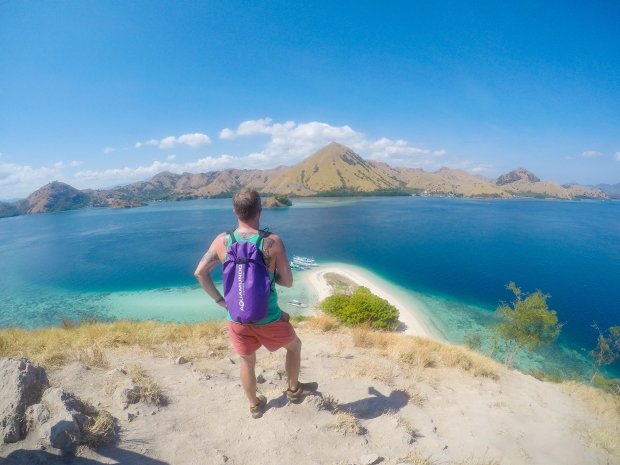
After taking in the view, we snorkeled around the island for a long time. We saw so many colorful coral, including a kind I haven’t seen before. It looked like a red shower loofah (the colorful poofy kind with the layered mesh fabric).
Back on the boat, our crew prepared a delicious lunch for us. Every meal we had on our boat was delicious veggie and seafood based. Mealtime became something I looked forward to throughout the trip.

The next stop was why I came here- Rinca Island, home to many Komodo Dragons. Ever since I was a kid and saw these crazy animals in a nature documentary, I’ve wanted to see them. And we did!
When we arrived, a park ranger greeted us. Visitors must be with a ranger at all times for safety.

The Komodo dragon is a monitor lizard, but a very extraordinarily big one. Growing up to 3m in length and weighing up to 100kg, they are omnivorous, emphasis on the omni. They will hunt mammals weighing up to 100kg and even eat their young. Juvenile dragons hide in trees to avoid becoming a meal for adults.
They can stand on their back legs and knock over prey with one whack of their powerful tails. On top of that, they are venomous. Just one bite will cause septic infections that inevitably kill the victim. The lizard will follow its victim until it dies, which can take up to two weeks.
Thankfully, they only need to eat once a month, which means it’s relatively safe to observe them in the company of a park ranger.
As if they couldn’t be any scarier, female dragons kept isolated from other dragons their entire lives have recently been observed in zoos giving birth to fertilized eggs.
Right away on the island, we saw 7 dragons sleeping near the park ranger kitchen. They say they don’t feed them, but the dragons must have access to scraps. Otherwise, it doesn’t make sense that so many would hang out there.
We then headed out on a nature trail with our ranger. At the start of the trail, in an open grassy area, we saw a massive 2.5 meter long male ambling towards us. He was every bit like what those nature documentaries showed. He stuck his tongue in and out in quick bursts as he slowly sauntered across the grass. Eventually he stopped, arched his back dramatically, and lay down to rest.


Komodo Dragon on Rinca Island
I was in awe. This was like National Geographic before my own eyes.
After a while of observing this magnificent beast (and taking some strategically angled photos to exaggerate his size), our ranger led us through the trail into a more wooded area. The rest of the walk was pretty uneventful. The ranger explained that it was mating season, so the dragons would be in more secluded places and thus less likely to be seen on the trails.
Towards the end of the walk, though, we did see a smaller dragon – a juvenile female. We felt really lucky to see her, since females in particular are rare to see during the mating season.
After this it was back on our little boat to head to Kalong Island for the night. Our guide told us we were going to watch flying foxes, but we didn’t know what those were or what to expect.
As the sun began to set after we’d tied up with other boats, there was a rumble in the water that created a large swell. The entire boat shook dramatically, knocking things over in its wake. We aren’t sure what happened, but we think maybe it was an underwater volcano or small earthquake tremor – neither of which would be unusual in Indonesia.
Once the commotion passed, we settled in to watch the sunset from the roof of the boat. Soon we saw what our guide was talking about when he said we’d see flying foxes.
It turns out flying foxes are bats, and every evening millions (literally) fly out of the mangroves, where they hang out during the day. We watched their silhouettes against the rainbow sky for almost an hour before motoring to our overnight spot. They were still streaming out hundreds at a time as we left.


We couldn’t believe how many bats swarmed out of the mangroves
The next morning our first stop was to Padar Island. A steep hike up to a view point rewards sweaty climbers with an absolutely epic view of three bays. Each has a different colored sandy shore (black, white and pink) sandwiched between the lush green island foliage and the turquoise water. It is one of the most impressive views I’ve ever seen.

We spent a little over an hour on Padar Island before returning to our boat and heading to Pink Beach, so-called because of its pink sand. Admittedly, it was more beige than pink, but still a nice beach to visit. The snorkeling in particular was really good, with a lot of vibrant coral to see.

After another great lunch, it was time to try to find more dragons on Komodo Island. Much like at Ringa Island, visitors must explore the island with a ranger. There are several options available for walking around the island. We chose the “medium” option. We saw four dragons during the walk, all lazing in shady and breezy places near the beach.
Komodo Island, compared to Ringa, felt a bit more artificial. There is a man made water hole in the woods for the express purpose of luring dragons, and our ranger even poked a dragon on his hind leg to spur him to walk. Presumably, the ranger thought this is what we wanted to see. I hope this was a one off occurrence, but my gut tells me that without better regulations, the Komodo Islands could easily head into the realm of harmful animal tourism.

Back on the boat, we headed to our overnight destination at Gili Lawa. We did a short hike up to a sunset viewpoint before another delicious dinner. The next morning we had the option of hiking up even higher in the dark to catch sunrise from another viewpoint, but we opted to sleep longer instead.
We spent most of our last morning on the boat looking for manta rays at Manta Point. We didn’t find any, but we did hang out on a beautiful little island called Kanawa Island and snorkeled a bit.
After resting on the island, we went looking for manta rays again. While we never found a manta, we did see an eagle ray swimming by very quickly, his black body with white dots a blur as it zipped by us. We also saw three large sea turtles during our snorkel, and in my opinion, any day you see a sea turtle is a great day
We arrived back at Labuan Bajo early that afternoon. It was our last night in Indonesia, and while scrolling through a female travelers community group on Facebook, I saw another member of the group was in the same small town as us. We connected and met up for dinner and drinks. It was a great way to say goodbye to this beautiful country.
Indonesia’s epic volcanos, majestic snorkeling, and warm locals put this island country solidly among our favorites in the world. Even with three weeks there, we barely grazed the surface of all it offers. We learned of so many other places to see in Indonesia that we’re already talking about going back (perhaps with a stopover in another favorite spot – Singapore!).
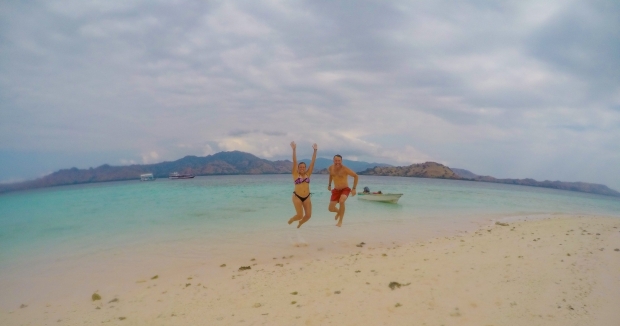


3 thoughts on “Take Me Back to Indonesia”